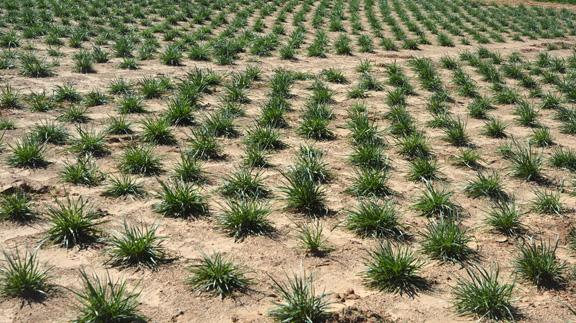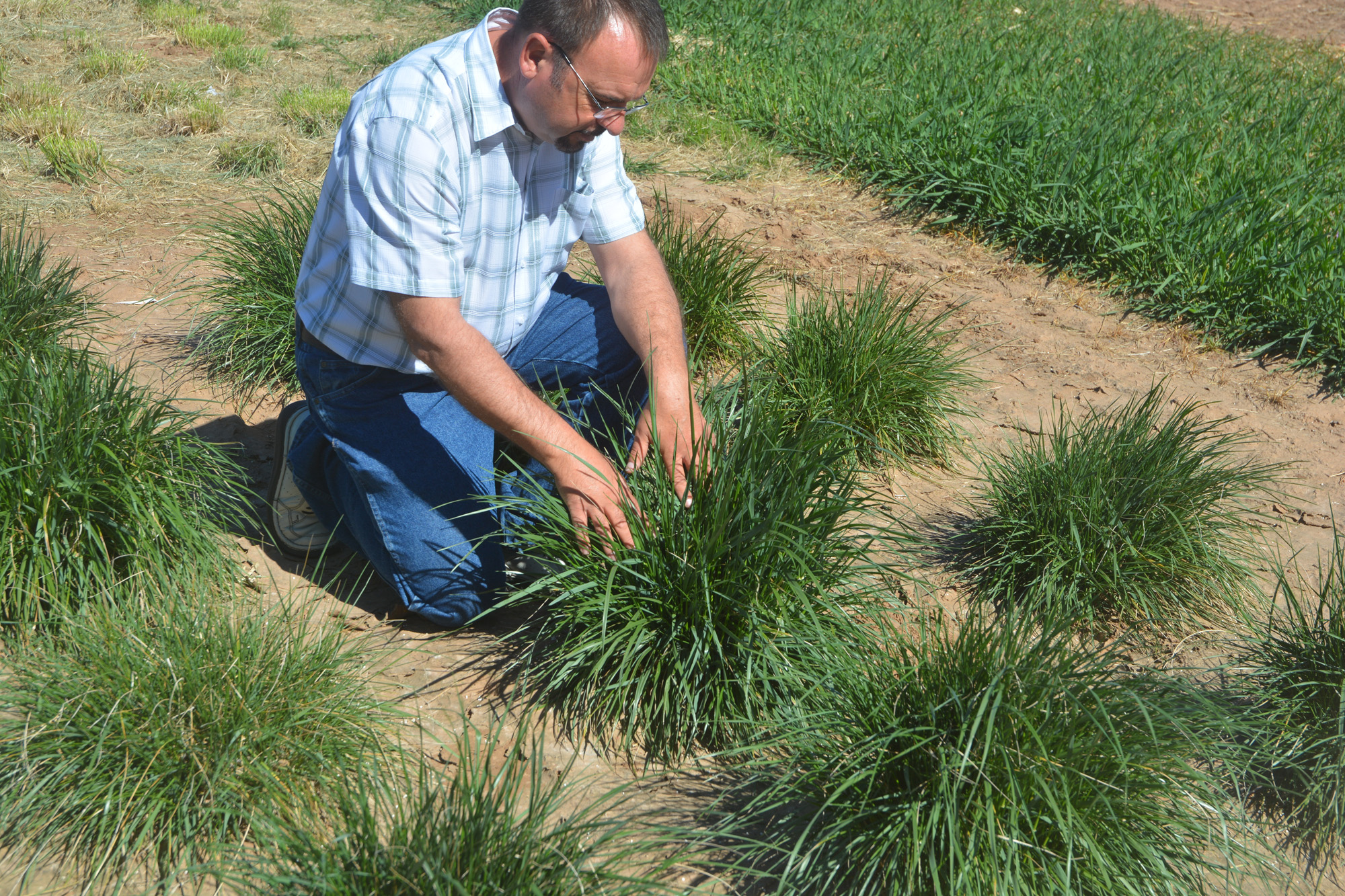Farm & Ranch
Summer-dormant cool-season grasses good option for perennial pastures

By: Kay Ledbetter
Writer: Kay Ledbetter, 806-677-5608, [email protected]
Contact: Dr. Dariusz Malinowski, 940-552-9941, [email protected]
VERNON – The past El Nino autumn and winter offered a good opportunity to establish pastures of summer-dormant tall fescue in Texas and Oklahoma, according to Dr. Dariusz Malinowski, a Texas A&M AgriLife Research forage agronomist and plant breeder in Vernon.

Dr. Dariusz Malinowski, Texas A&M AgriLife Research-Vernon, looks at summer-dormant cool-season grasses in his research plots near Vernon. (Texas A&M AgriLife Communications photo by Kay Ledbetter)
Dr. Dariusz Malinowski, Texas A&M AgriLife Research-Vernon, looks at summer-dormant cool-season grasses in his research plots near Vernon. (Texas A&M AgriLife Communications photo by Kay Ledbetter)
“A number of producers inquired about the availability of summer-dormant tall fescue seed last summer, and these producers had luck with stand establishment last autumn,” Malinowski said. “The first growing season is the most critical to establish summer-dormant tall fescue pasture, and it looks like the weather has been cooperating so far.”
For more than 10 years, he has been researching and evaluating a number of cool-season grasses originating from the Mediterranean Basin in environments with harsh summer droughts and mild winters, resembling Texas climate conditions.
These grass ecotypes possess a summer dormancy trait that allows them to survive six months without precipitation, in blistering heat, Malinowski said.
“There is no doubt in my opinion that summer-dormant cool-season grasses will be the only option for cool-season perennial forage for a long time, considering the climate projections for the Southern Great Plains.”
He said climate change is projected to progress in the U.S. in the next couple of decades. The U.S. Global Change Research Program report predicts by the end of the century, the average U.S. temperature may increase by 4-6 degrees under the lower greenhouse gas emissions scenario or by 7-10 degrees under the higher emissions scenario.
Climate models suggest much of the Southeast and Southwest will become drier, especially in winter and spring, resulting in increased drought severity and duration, he said.
“These changes began taking place in Texas in the mid to late 1990’s and have been progressing ever since,” Malinowski said. “We all remember the devastating drought of 2011 in the Southern Great Plains, and 2015 had the highest average temperature ever recorded.”
Producers rely on cool-season forages to sustain millions of grazing cattle each winter in this region, with wheat the major source of high-quality forage, he said. But abrupt patterns of autumn precipitation occurred quite often in the past years, delaying wheat planting and resulting in a lack of sufficient forage production.
“Producers are increasingly interested in planting perennial cool-season pastures that may serve as a complementary forage source to wheat or replace wheat grazing systems and balance the effects of weather extremes,” Malinowski said.
Unfortunately, he said, most of the traditionally planted cool-season perennial forage grasses are now history in Texas and most of the Southern Great Plains because of their inability to cope with progressing aridity.
“We took the climate change predictions very seriously in the early 2000s, when I started to lead the forage systems program at Vernon,” Malinowski said.
“Consequently, we initiated a collaborative research with Grasslands Innovation of New Zealand in 2008 to breed new cultivars of summer-dormant tall fescue, orchardgrass and perennial ryegrass with improved forage productivity and quality, and superior persistence.”
He said several breeding lines are in the final stages of cultivar development and will be available to producers in the next few years.
Developing a new forage grass cultivar is not a fast track achievement.
“Similar to wheat, it takes about eight to 10 years to accomplish this goal,” Malinowski said.
Meanwhile, producers have had a choice of two commercial cultivars of summer-dormant tall fescue in the U.S. – Flecha by Grasslands Innovation and Prosper by Barenbrug USA. In the past years, these cultivars were planted across Texas and Oklahoma and persisted well until the historic drought of 2011, he said.
“Repeated lack of precipitation during several subsequent winter growing seasons and the resulting inability to replenish resources exhausted the grass plants beyond their level of tolerance,” Malinowski said.
There has been some concern the introduction of summer-dormant cool-season grasses to environments of the Southern Great Plains and the Mediterranean environments of California may result in these species becoming invasive to native flora, as was the case with summer-active tall fescue introduced to the U.S. in the 1800s, he said.
“Summer-dormant cool-season grasses, tall fescue in particular, are genetically and physiologically distinct from the summer-active variants; thus their potential to be invasive is not similar,” Malinowski said.
Preliminary research suggests summer-dormant grasses originating from the Mediterranean Basin and introduced to Mediterranean-like environments of California have very limited potential for invasiveness when compared with introduced Mediterranean annuals and native summer-dormant grasses.
“Our data show that summer-dormant tall fescue is less competitive than continental tall fescue when both types were grown in binary mixtures with alfalfa, especially when constrained by low soil moisture availability in summer,” he said.
In non-native environments such as those of the Southern Great Plains, summer-dormant tall fescue will not be able to take advantage of summer soil moisture, in contrast to native temperate and warm-season flora, because its growth pattern is highly restricted, Malinowski said.
“Summer-dormant cool-season grasses were introduced to southern Australia about 50 years ago and did not develop into environmental weeds,” he said.
Malinowski said many producers also want to incorporate a forage legume crop to grow with summer-dormant tall fescue.
“In collaboration with Dr. Twain Butler of the Samuel Roberts Noble Foundation in Ardmore, Oklahoma, we evaluated the compatibility of a range of forage legumes, including alfalfa and annual medics. Annual medics, having a very similar growth pattern to summer-dormant tall fescue, were the most suitable to grow in mixed stands with summer-dormant tall fescue,” he said.
Producers interested in growing summer-dormant tall fescue should contact their local Texas A&M AgriLife Extension Service agent or Malinowski at 940-552-9941, ext. 240.
-30-
LikeTweet
Find more stories, photos, videos and audio at http://today.agrilife.org
Farm & Ranch
Acorn Toxicity

By Barry Whitworth, DVM, MPH
With the prolonged drought, most pastures in Oklahoma end up in poor condition. With the lack of available forage, animals may go in search of alternative foods.
If oak trees are in the pastures, acorns may be a favorite meal for some livestock in the fall. This may result in oak poisoning.
Oak leaves, twigs, buds, and acorns may be toxic to some animals when consumed.
To read more, pick up a copy of the November edition of North Texas Farm & Ranch magazine, available digitally and in print. To subscribe by mail, call 940-872-5922.

Farm & Ranch
Silver Bluestems

By: Tony Dean
There are a handful of grasses on North Texas grazing lands ranchers need to know, not because they are highly desirable, but rather because they are not of much value. I call them “decom” plants, which is am acronym for “Don’t Ever Count On Me.” Silver bluestem is a “decom” grass.
Silver bluestem is a perennial which grows in all areas of Texas. It can survive in almost all soil types, and in full sun conditions or in semi shade. It grows up to three feet tall and is easily recognized with the presence of the white fuzzy seed head. Also, one of the identifying characteristics of Silver bluestem is a bend in the stems at each node, causing the plants to take on a rounded shape as they mature.
To read more, pick up a copy of the November edition of North Texas Farm & Ranch magazine, available digitally and in print. To subscribe by mail, call 940-872-5922.

Farm & Ranch
Meanwhile Back At The Ranch

By: Rayford Pullen
Fall is here which means winter is closing in on us and before we officially get into winter, we need to make sure our factories are either producing or will be producing in a few months.
We have been pregnancy testing our cows this fall and if they are not bred or nursing a calf, we are bidding them adios. With annual costs somewhere between $900.00 and $1,000.00 per cow, those cows not producing a live weaned calf are costing us quite a bit.
To read more, pick up a copy of the November edition of North Texas Farm & Ranch magazine, available digitally and in print. To subscribe by mail, call 940-872-5922.
-

 Country Lifestyles2 years ago
Country Lifestyles2 years agoScott & Stacey Schumacher: A Growth Mindset
-

 Country Lifestyles8 years ago
Country Lifestyles8 years agoStyle Your Profile – What your style cowboy hat says about you and new trends in 2017
-

 HOME8 years ago
HOME8 years agoGrazing North Texas – Wilman Lovegrass
-

 Equine1 year ago
Equine1 year agoThe Will to Win
-

 Country Lifestyles5 years ago
Country Lifestyles5 years agoAmber Crawford, Breakaway Roper
-

 Outdoor9 years ago
Outdoor9 years agoButtercup or Primrose?
-

 Country Lifestyles8 years ago
Country Lifestyles8 years agoJune 2016 Profile – The man behind the mic: Bob Tallman
-

 Country Lifestyles8 years ago
Country Lifestyles8 years agoDecember 2016 Profile, Rusty Riddle – The Riddle Way




